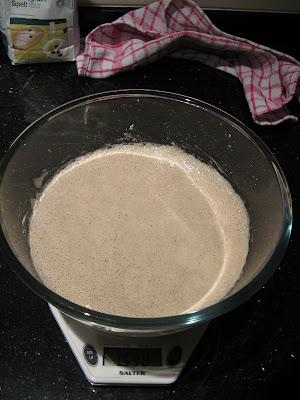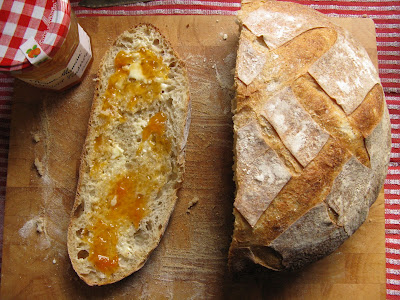 |
| Large Sourdough Sandwich Loaf |
This is briefly how I made it - please refer to earlier sourdough loaf posts for step-by-step photos and details of techniques:
Ingredients:
For the sponge:
- 90-100 grams ripe 100% hydration starter (N.B. Remember to keep 10 grams of your starter back to refresh as your ongoing starter)
- 375 grams strong white bread flour (I used Carr's Strong White Bread Flour)
- 500 grams filtered tap water (approx. 60% hydration loaf)
- 450 grams strong white bread flour or seeded/granary flour (I used Allinson's Seed & Grain Bread Flour)
- 15 grams milled sea salt
This recipe generates approx. 1.350 kg of dough and approx 1.3 kg loaf.
I put the ingredients together for the sponge in the evening and left it covered with a tea towel at room temperature overnight.
The next morning I added the remaining flour and the salt and worked the dough for 10 min.
The dough was left to ferment at room temperature for 2 hours, with a fold after the first hour.
It was then shaped into a batard and placed seam-side down into a buttered 1 kg/2 lb loaf tin. The anodised tin by Mermaid, (measuring 24 cm L x 13 cm W x 8 cm H) is particularly good, although it needs seasoning before first use otherwise the loaf will stick.
The dough was then left to prove at room temperature (quite a warm day) for about 4 and a half hours (until double in size with some spring-back when the dough is prodded).
I thought I'd try a cold-oven start for the baking - I placed hot water in a tray at the bottom of the oven (to generate some steam whilst the crust was forming) and put the loaf tin in the cold oven on the middle shelf.
N.B. this is using a fan-assisted electric oven:
It took about 15 min for the oven to reach 200 degrees C, during which time the loaf had risen quite a lot - the theory is that a cold-oven start promotes greater oven-spring.
When the oven had reached 250 degrees C 5 min later, I rotated the loaf 180 degrees (to even the browning).
Turning the temperature down to 200 degrees C 5 min later, the loaf was left to bake for a further 10 min after which the oven was turn off.
The loaf was removed from the oven 5 min later, promptly removed from the tin and left to cool on a wire rack.
To summarize:
00:00 cold oven with hot water in tray
00:15 reached 200 degrees C
00:20 reached 250 degrees C, rotated loaf 180 degrees
00:25 temp reduced to 200 degrees C
00:35 oven turned off, loaf left in
00:40 loaf removed from oven and tin, and left to cool...
 |
| Delicious! |




























































